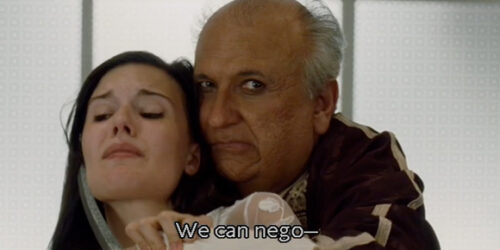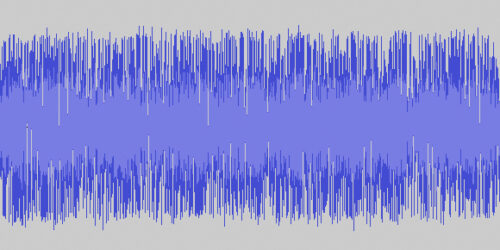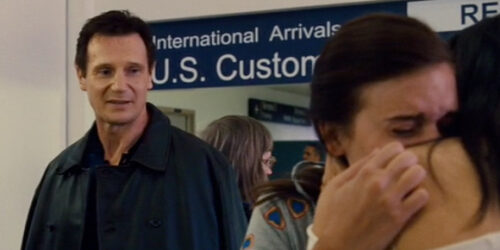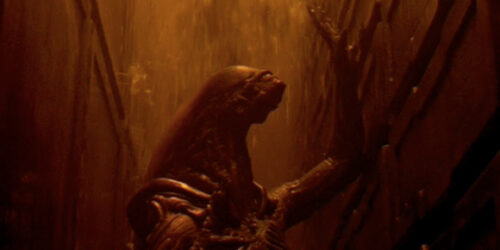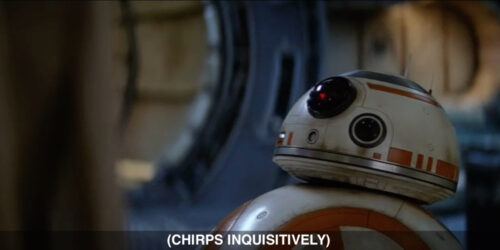The power of dots and dashes to tell the future
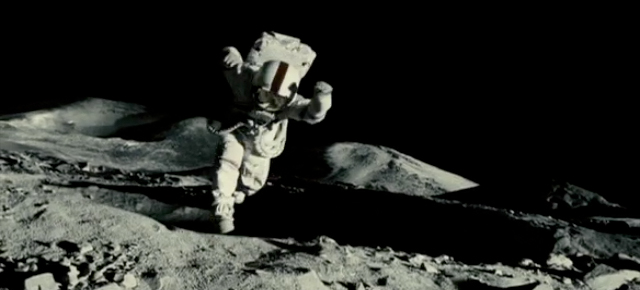
Sometimes, punctuation in captions can provide important clues about what’s going to happen, regardless of how well or poorly timed the captions are.
A concern for well-timed captions is included in every definition of caption quality. Along with placement, accuracy, completeness, typography, and style (e.g. pop on or scroll up), timing is a key aspect of quality, particularly for Internet-delivered, prerecorded TV shows and streamed DVDs (where timing can be precisely controlled using “pop on” style captions). For example, according to the “First Report of the Video Programming Accessibility Advisory Committee on the Twenty-First Century Communications and Video Accessibility Act of 2010” (dated July 13, 2011), “the consumer must be given an experience that is equal to, if not better than, the experience provided as the content was originally aired on television.” A quality experience is defined in terms of completeness, placement, accuracy, timing, and media player capabilities (color, opacity, size, typefaces, etc.). The FCC’s recent statement on quality captioning for “Internet Protocol-Delivered Video Programming” continues to define quality in terms of a “consideration of such factors as completeness, placement, accuracy, and timing.”
Because viewers’ reading speed doesn’t align word for word with the speed of actors’ spoken delivery, and because reading speed varies from viewer to viewer, timing can never be fully controlled. A fast-reading viewer may finish reading a line of dialogue before a slow-speaking actor has finished delivering that line. What might start out as a perfectly timed caption can end up out of sync when readers finish reading before actors finish speaking.
If you’ve ever laughed at a captioned punchline before it’s been completely delivered in speech, even when that caption has been perfectly timed to appear when the first word of the punchline is uttered, then you have experienced one of the productive tensions between listening and reading.
Predicting the future with only dots and dashes
In some well-defined situations, caption viewers are able to glimpse the future by reading ahead and drawing on their knowledge of what’s transpired in the film or TV show thus far. Even something as seemingly minor as a dash or an ellipsis at the end of a caption can speak volumes to experienced caption readers. The timing of captions can play a role in making predictions, but the kind of viewing experience I’m talking about does not depend solely on caption timing. It depends on reading speed, one’s level of experience with closed captions, and the nature of pop-on style captioning (which permits viewers to read ahead into the future).
Let me share five examples of how dots and dashes provide clues to caption viewers about what’s about to happen.
1. Apollo 18 (2011)
In one scene from Apollo 18, Nate is suddenly pulled into a dark moon crater by some unknown force or creature. Every viewer can probably sense that something bad is going to happen because 1) that same scary crater was featured earlier in the film as a foreboding and dangerous spot, 2) Nate has been acting funny and now teeters on the edge of the crater, 3) the dialogue calls up our prior experiences of other movie scenes in which characters go down screaming “Save yourself!”, and 4) this is a horror movie (where scary things happen suddenly). But caption viewers have an extra bit of information in the ellipsis — if they can read fast enough and have enough prior experience with captions — that allows them to have advance knowledge of the moment when something dramatic will happen to prevent Nate from finishing his sentence.
When I first watched this movie on DVD, I surmised correctly, before Nate was pulled into the crater, that the ellipsis signaled the end of the conversation between the astronauts and the beginning of a sudden shift in focus. It’s always just a guess, and it must take place in a split second. I knew the scene wouldn’t end well and the caption gave me a clue as to the timing of the bad event. Sometimes we guess wrong. But I would suggest that experienced caption viewers are continually making educated guesses like this one as they read ahead. At the very least, the ellipsis tells us that something dramatic will happen to prevent the speaker from finishing his sentence. We may not know exactly what will happen, but we glimpse the future nonetheless.
2. Taken (2008)
At the end of Taken (2008), Liam Neeson finally tracks down his kidnapped daughter and proceeds to kill the final kidnapper as swiftly as he killed the other bad guys along the way. The movie poster has promised nothing less from Neeson’s character: “I don’t know who you are but if you don’t let my daughter go, I will find you and I will kill you.” So it shouldn’t come as a surprise that, just as Neeson has done with the previous bad guys along the way, this final bad guy will suffer a similar fate. But caption viewers have an extra bit of information in the dash that allows them to know precisely when he will be shot by Neeson.
We surmise ahead of time that the reason the bad guy can’t finish saying the word “negotiate” is because Neeson shoots him. The caption is poorly timed too, giving viewers ample time not only to read the line before it is spoken but to make an educated guess about the bad guy’s fate. It’s not hard to guess what’s going to happen when we consider Neeson’s take-no-prisoners style (negotiation is not an option!) and the audience’s expectation of a happy ending (i.e. daughter unharmed and returned to her family; bad guys pay the ultimate price). The dash on “nego–” allows us to predict when that price will be paid by the final bad guy.
3. 30 Rock (2008)
At the beginning of the untitled 10th episode of Season 2 of 30 Rock, Kenneth is sprayed with steam from a new cappuccino machine before he can finish saying his own name:
I really had no idea what was coming. I just could see in a split second that something was going to interrupt Kenneth’s phone greeting. What the dash on “Ke–” tells us an instant before those watching without captions is that Kenneth will be interrupted by something. We can only guess what that something will be. (The episode thus far has focused on that new cappuccino machine, so perhaps the interruption will involve that mach–?)
4. Psych (2010)
Sometimes, an ellipsis or dash doesn’t foreshadow a major interruption (like a powerful moon force, gunshot, or coffee machine spraying steam) but merely an emotional pause or break. In this clip from an episode of Psyche entitled “Shawn 2.0” (2010), Curt Smith from Tears for Fears stops singing mid-sentence, presumably after seeing a look of shock on Shawn’s face. We know the interruption is coming because we can easily read ahead and see it coming in the dash. That’s all the dash tells us here. (If we’re fans of Tears for Fears, we also know what word is missing.)
5. Futurama (2008)
At other times, things happen so quickly that we can barely keep up, let alone read ahead. In this clip from an episode of Futurama entitled “Bender’s Big Score” (2008), the alien scammers have taken everything worth anything and thrown the gang out on the street. Dr. Zoidberg’s response to being fired is short (only one second long) and the accompanying caption is timed about 3/10th of a second too late, which doesn’t really allow readers any time to make a prediction about the meaning of the ellipsis or what’s coming.
Conclusion: Caption viewers can sometimes read ahead into the future
The issue of timing in pop-on style captioning usually refers only to the first word or sound in each caption. Captioners are encouraged to make sure that each caption appears at precisely the moment when the first sound/word in that caption is uttered. After the first word, all bets are off for when (or even whether) viewers will finish reading the remaining words in the caption. When speakers speak more slowly than caption viewers read, the latter can sometimes read ahead of the former’s spoken dialogue. Poorly timed captions can enable or hinder this practice of reading ahead. Differing literacy levels among readers complicate things even further.
Here’s the larger point: Through the eyes of experienced caption readers, even something as seemingly insignificant as punctuation — a dash or a couple dots — can provide important clues about the future, regardless of how well or poorly timed the captions are.
[Fair use notice: The videos on this site are transformative works used in good faith, in keeping with Section 107 of U.S. copyright law, and as such constitute fair use of copyrighted material. Read this site’s full fair use notice.]

